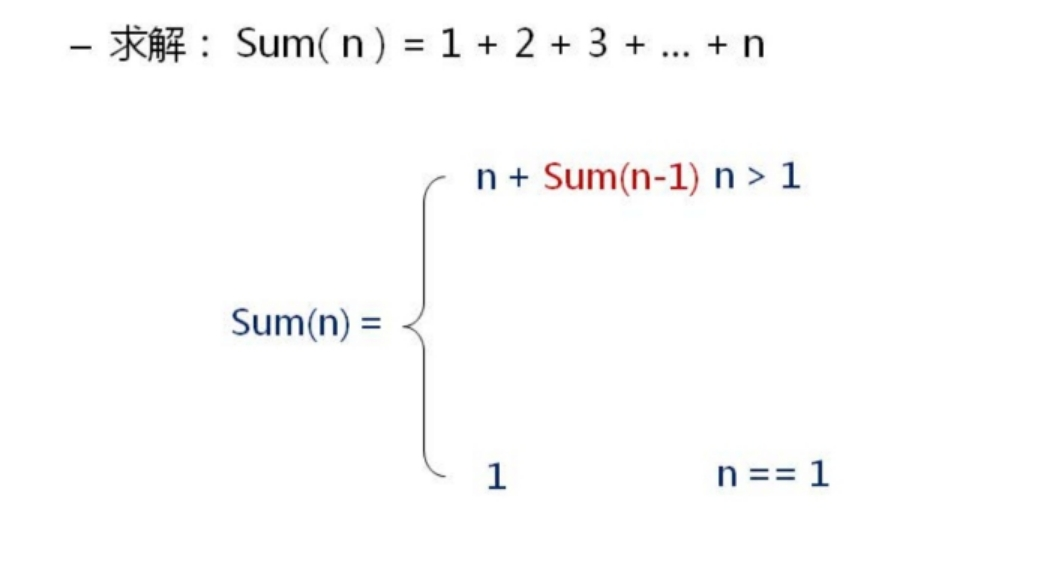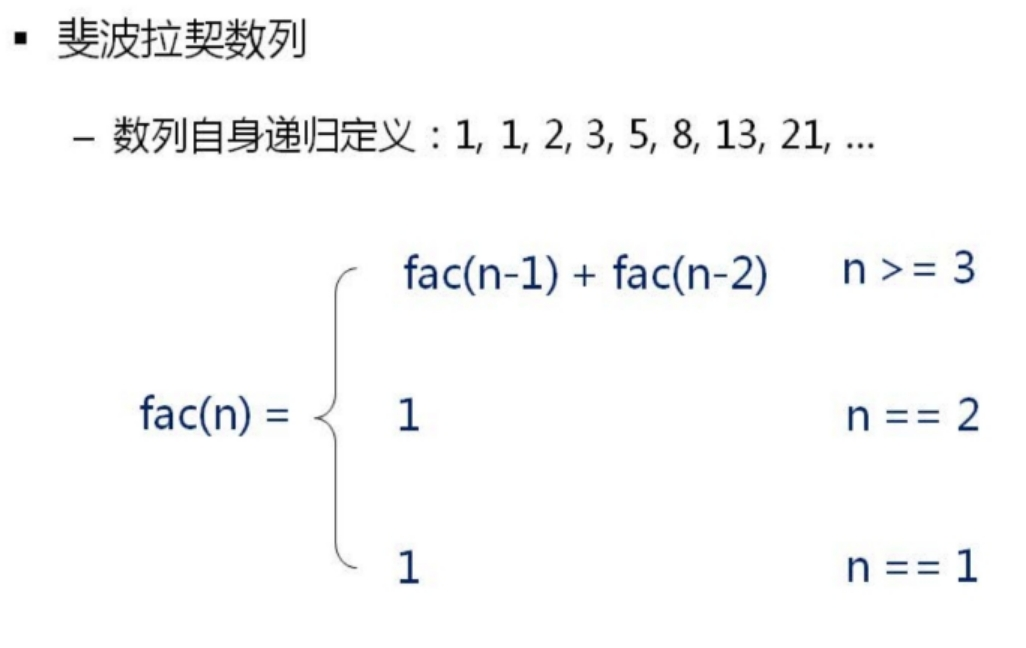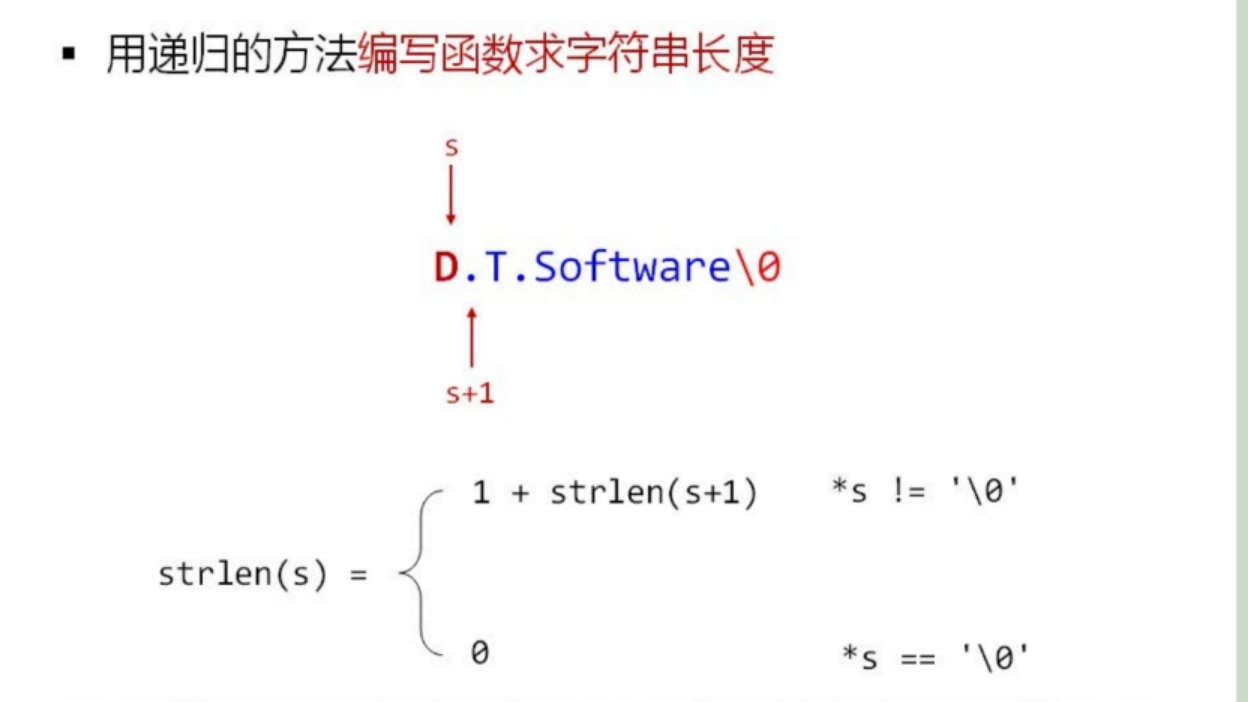将一个问通过递归来解决的思路是:
1. 将原问题不断分解为相同模型的子问题。
2. 寻找边界条件,当不满足边界条件则继续分解问题,满足则开始求解。
eg:
1.求和

模型:
1. 将原问题不断分解为相同模型的子问题(前N项和可以分解为n加上n-1的前n-1项和 Sum(n) -> n + Sum(n-1))。
2. 寻找边界条件,当不满足边界条件则继续分解问题 (n > 1),满足则开始求解 (n == 1)。
实现:
unsigned int sum(unsigned int n) { if(n != 1) { return (n + sum(n -1)); } else { return 1; } }
2. 求斐波那契数

模型:
1. 将原问题不断分解为相同模型的子问题 (一个下标对应的斐波那契数为前两个斐波那契数之和 fac(n) -> fac(n-1) + fac(n-2))。
2. 寻找边界条件,当不满足边界条件则继续分解问题 ,满足则开始求解 (n == 1 || n == 2)。
实现:
unsigned int fac(unsigned int n) { if(n > 2) { return (fac(n - 1) + fac(n - 2)); } else if((n == 1) || (n == 2)) { return 1 } return 0; }
3. 求字符串长度

模型:
1. 将原问题不断分解为相同模型的子问题 ( 一个字符串长度分解为首字符加剩余字符长度strlen(s) -> 1 + strlen(s-1) )。
2. 寻找边界条件,当不满足边界条件则继续分解问题(没有遍历到'�') ,满足则开始求解 (遍历到'�')。
实现:
unsigned int strlen(unsigned char* str) { unsigned int len = 0; if(*str != '�') { return (1 + strlen(str)); } else { return 0; } } unsigned int strlen(unsigned char* str) { return str ? (*str ? (1 + strlen(str)) : 0) : 0; }
反转链表:
Node *list_reverse(Node *list) { if(list == NULL && list->next == NULL) { return list; } else { Node *slide = list->next; Node *ret = list_reverse(list->next); list->next = NULL; slide->next =list; return ret; } }
合并链表:
Node *list_merge(Node* list_1, Node* list_2) { if(list_1 == NULL) { return list_2; } if(list_2 == NULL) { return list_1; } if(list_1->vlaue < list_2->value) { Node* list_1_slide = list_1->next; Node* ret = list_merge(list_1_slide, list_2); list_1->next = ret; return list_1; // return (list_1->next = list_merge(list_1->next, list_2), list_1); } else if(list_1->vlaue > list_2->value || list_1->vlaue == list_2->value) { Node* list_2_slide = list_2->next; Node* ret = list_merge(list_1, list_2_slide); list_2->next = ret; return list_2; // return (list_2->next = list_merge(list_1, list_2->next), list_2); } }
汉诺塔
void HanoiTower(int n, char a, char b, char c)// a:src b:mid c:dest { if(n == 1) { cout << a << --> << b << endl; } else { HanoiTower(n - 1, a, c, b); HanoiTower(1, a, b, c); HanoiTower(n - 1, b, a, c;) } }
全排列:
八皇后:
1.创建9*9的边界,边界值为2,空白值为0,放置皇后值为1.
2. 每一个cell检测其是否可以放置皇后的是检测(-1,-1)(0,-1)(1,-1)三个方向是否有皇后
3. 以检测一行哪个位置适合放置皇后为基础,当出现当前行没有皇后位则返回上一行重新寻找下一个皇后位。
template <int SIZE> class EightQueuen : public TopClass { protected: enum{ N = SIZE + 2}; struct cell : public TopClass { cell(int x = 0, int y = 0) : px(x), py(y) {} int px; int py; }; int chessboard[N][N]; LinkList<cell> m_solution; int m_count = 0; void init() { for(int x = 0; x < N; x += N - 1) { for(int y = 0; y < N ; y++) { chessboard[x][y] = 2; chessboard[y][x] = 2; } } for(int x = 1; x < N - 1; x++) { for(int y = 1; y < N - 1; y++) { chessboard[x][y] = 0; } } } void show_resolution() { for(m_solution.move(0); !m_solution.end(); m_solution.next()) { cout << "(" << m_solution.current().px << "," << m_solution.current().py << ") " ; } cout << endl; for(int y = 0; y < N; y++) { for(int x = 0; x < N; x++) { cout << chessboard[x][y]; } cout << endl; } cout << endl; } bool cell_check(int x, int y) { bool ret = 1, flag = 1,flag1,flag2,flag3; int temp_x = x, temp_y = y; int dir_1 = 0, dir_2 = 0, dir_3 = 0; do{ temp_x = temp_x + (-1); temp_y = temp_y + (-1); flag = (chessboard[temp_x][temp_y] == 0); }while(flag); flag1 = (chessboard[temp_x][temp_y] == 2); temp_x = x; temp_y = y; do{ temp_x = temp_x + (0); temp_y = temp_y + (-1); flag = (chessboard[temp_x][temp_y] == 0); }while(flag); flag2 = (chessboard[temp_x][temp_y] == 2); temp_x = x; temp_y = y; do{ temp_x = temp_x + (1); temp_y = temp_y + (-1); flag = (chessboard[temp_x][temp_y] == 0); }while(flag); flag3 = (chessboard[temp_x][temp_y] == 2); return (flag1 && flag2 && flag3); } bool line_check(int y) { if(y <= SIZE) { for(int x = 1; x <= SIZE; x++) { if(cell_check(x,y)) { chessboard[x][y] = 1; m_solution.insert(cell(x,y)); line_check(y + 1); chessboard[x][y] = 0; m_solution.remove(m_solution.length() - 1); } } } else { show_resolution(); m_count++; } } public: EightQueuen() { init(); } void process() { line_check(1); cout << "Total Solution = " << m_count << endl; } }; int main(void) { EightQueuen<8> eq; eq.process(); return 0; }